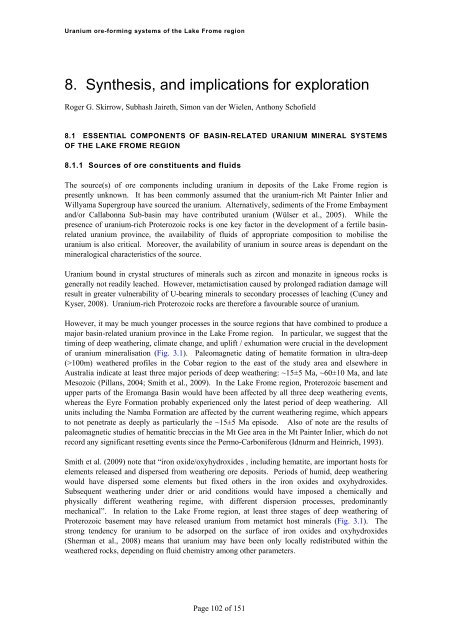Uranium ore-forming systems of the - Geoscience Australia
Uranium ore-forming systems of the - Geoscience Australia
Uranium ore-forming systems of the - Geoscience Australia
You also want an ePaper? Increase the reach of your titles
YUMPU automatically turns print PDFs into web optimized ePapers that Google loves.
<strong>Uranium</strong> <strong>ore</strong>-<strong>forming</strong> <strong>systems</strong> <strong>of</strong> <strong>the</strong> Lake Frome region8. Syn<strong>the</strong>sis, and implications for explorationRoger G. Skirrow, Subhash Jaireth, Simon van der Wielen, Anthony Sch<strong>of</strong>ield8.1 ESSENTIAL COMPONENTS OF BASIN-RELATED URANIUM MINERAL SYSTEMSOF THE LAKE FROME REGION8.1.1 Sources <strong>of</strong> <strong>ore</strong> constituents and fluidsThe source(s) <strong>of</strong> <strong>ore</strong> components including uranium in deposits <strong>of</strong> <strong>the</strong> Lake Frome region ispresently unknown. It has been commonly assumed that <strong>the</strong> uranium-rich Mt Painter Inlier andWillyama Supergroup have sourced <strong>the</strong> uranium. Alternatively, sediments <strong>of</strong> <strong>the</strong> Frome Embaymentand/or Callabonna Sub-basin may have contributed uranium (Wülser et al., 2005). While <strong>the</strong>presence <strong>of</strong> uranium-rich Proterozoic rocks is one key factor in <strong>the</strong> development <strong>of</strong> a fertile basinrelateduranium province, <strong>the</strong> availability <strong>of</strong> fluids <strong>of</strong> appropriate composition to mobilise <strong>the</strong>uranium is also critical. M<strong>ore</strong>over, <strong>the</strong> availability <strong>of</strong> uranium in source areas is dependant on <strong>the</strong>mineralogical characteristics <strong>of</strong> <strong>the</strong> source.<strong>Uranium</strong> bound in crystal structures <strong>of</strong> minerals such as zircon and monazite in igneous rocks isgenerally not readily leached. However, metamictisation caused by prolonged radiation damage willresult in greater vulnerability <strong>of</strong> U-bearing minerals to secondary processes <strong>of</strong> leaching (Cuney andKyser, 2008). <strong>Uranium</strong>-rich Proterozoic rocks are <strong>the</strong>ref<strong>ore</strong> a favourable source <strong>of</strong> uranium.However, it may be much younger processes in <strong>the</strong> source regions that have combined to produce amajor basin-related uranium province in <strong>the</strong> Lake Frome region. In particular, we suggest that <strong>the</strong>timing <strong>of</strong> deep wea<strong>the</strong>ring, climate change, and uplift / exhumation were crucial in <strong>the</strong> development<strong>of</strong> uranium mineralisation (Fig. 3.1). Paleomagnetic dating <strong>of</strong> hematite formation in ultra-deep(>100m) wea<strong>the</strong>red pr<strong>of</strong>iles in <strong>the</strong> Cobar region to <strong>the</strong> east <strong>of</strong> <strong>the</strong> study area and elsewhere in<strong>Australia</strong> indicate at least three major periods <strong>of</strong> deep wea<strong>the</strong>ring: ~15±5 Ma, ~60±10 Ma, and lateMesozoic (Pillans, 2004; Smith et al., 2009). In <strong>the</strong> Lake Frome region, Proterozoic basement andupper parts <strong>of</strong> <strong>the</strong> Eromanga Basin would have been affected by all three deep wea<strong>the</strong>ring events,whereas <strong>the</strong> Eyre Formation probably experienced only <strong>the</strong> latest period <strong>of</strong> deep wea<strong>the</strong>ring. Allunits including <strong>the</strong> Namba Formation are affected by <strong>the</strong> current wea<strong>the</strong>ring regime, which appearsto not penetrate as deeply as particularly <strong>the</strong> ~15±5 Ma episode. Also <strong>of</strong> note are <strong>the</strong> results <strong>of</strong>paleomagnetic studies <strong>of</strong> hematitic breccias in <strong>the</strong> Mt Gee area in <strong>the</strong> Mt Painter Inlier, which do notrecord any significant resetting events since <strong>the</strong> Permo-Carboniferous (Idnurm and Heinrich, 1993).Smith et al. (2009) note that “iron oxide/oxyhydroxides , including hematite, are important hosts f<strong>ore</strong>lements released and dispersed from wea<strong>the</strong>ring <strong>ore</strong> deposits. Periods <strong>of</strong> humid, deep wea<strong>the</strong>ringwould have dispersed some elements but fixed o<strong>the</strong>rs in <strong>the</strong> iron oxides and oxyhydroxides.Subsequent wea<strong>the</strong>ring under drier or arid conditions would have imposed a chemically andphysically different wea<strong>the</strong>ring regime, with different dispersion processes, predominantlymechanical”. In relation to <strong>the</strong> Lake Frome region, at least three stages <strong>of</strong> deep wea<strong>the</strong>ring <strong>of</strong>Proterozoic basement may have released uranium from metamict host minerals (Fig. 3.1). Thestrong tendency for uranium to be adsorped on <strong>the</strong> surface <strong>of</strong> iron oxides and oxyhydroxides(Sherman et al., 2008) means that uranium may have been only locally redistributed within <strong>the</strong>wea<strong>the</strong>red rocks, depending on fluid chemistry among o<strong>the</strong>r parameters.Page 102 <strong>of</strong> 151
















